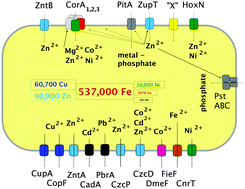Interplay between seven secondary metal uptake systems is required for full metal resistance of Cupriavidus metallidurans†
Abstract
The beta-proteobacterium Cupriavidus metallidurans is able to grow in metal-contaminated environments due to having sophisticated metal efflux systems. Here, the contribution of all seven known secondary metal uptake systems (ZupT, PitA, CorA1, CorA2, CorA3, ZntB, HoxN) to metal resistance is characterized. In a strategic deletion approach, all ten double deletion mutants, a variety of triple and quadruple mutants, and from the Δ4 mutant (ΔzupT ΔcorA1 ΔcorA2 ΔcorA3) the mutants Δ5 (=Δ4 ΔpitA), Δ6 (=Δ4 ΔpitA ΔzntB), and finally Δ7 (ΔzupT ΔcorA1 ΔcorA2 ΔcorA3 ΔpitA ΔzntB ΔhoxN) were constructed. Metal resistance, metal content, and regulation of expression of these genes were characterized in these mutants. The ΔzupT single deletion strain exhibited an extended lag phase in Tris-buffered liquid mineral salts medium (TMM) compared to its parent strain AE104, indicating a decreased fitness level. Further deletions up to Δ6 did not influence growth in TMM without added metals but fitness of the Δ7 strain dropped to a lower level compared to Δ6, Δ5 and ΔzupT. The cells of the Δ7 multiple deletion strain still contained all essential metals, demonstrating that additional metal import systems must exist in C. metallidurans. PitA was an important contributor of metal:phosphate complexes to C. metallidurans. Up to Δ5 no evidence was found for increased expression of the transporter genes to recruit substitutes for the deleted importers. Only the hoxN-lacZ reporter gene fusion displayed a changed expression pattern in the Δ6 strain, indicating recruitment of HoxN. Metal resistance of the deletion strains decreased along the deletion series although all strains still contained metal efflux systems: up to the Δ6 mutant the overall fitness was kept at the ΔzupT mutant strain level at the cost of a diminished competence to handle μM concentrations of transition metals. Together, these data demonstrated an important contribution of the seven secondary metal import systems to metal homeostasis in this bacterium.


 Please wait while we load your content...
Please wait while we load your content...